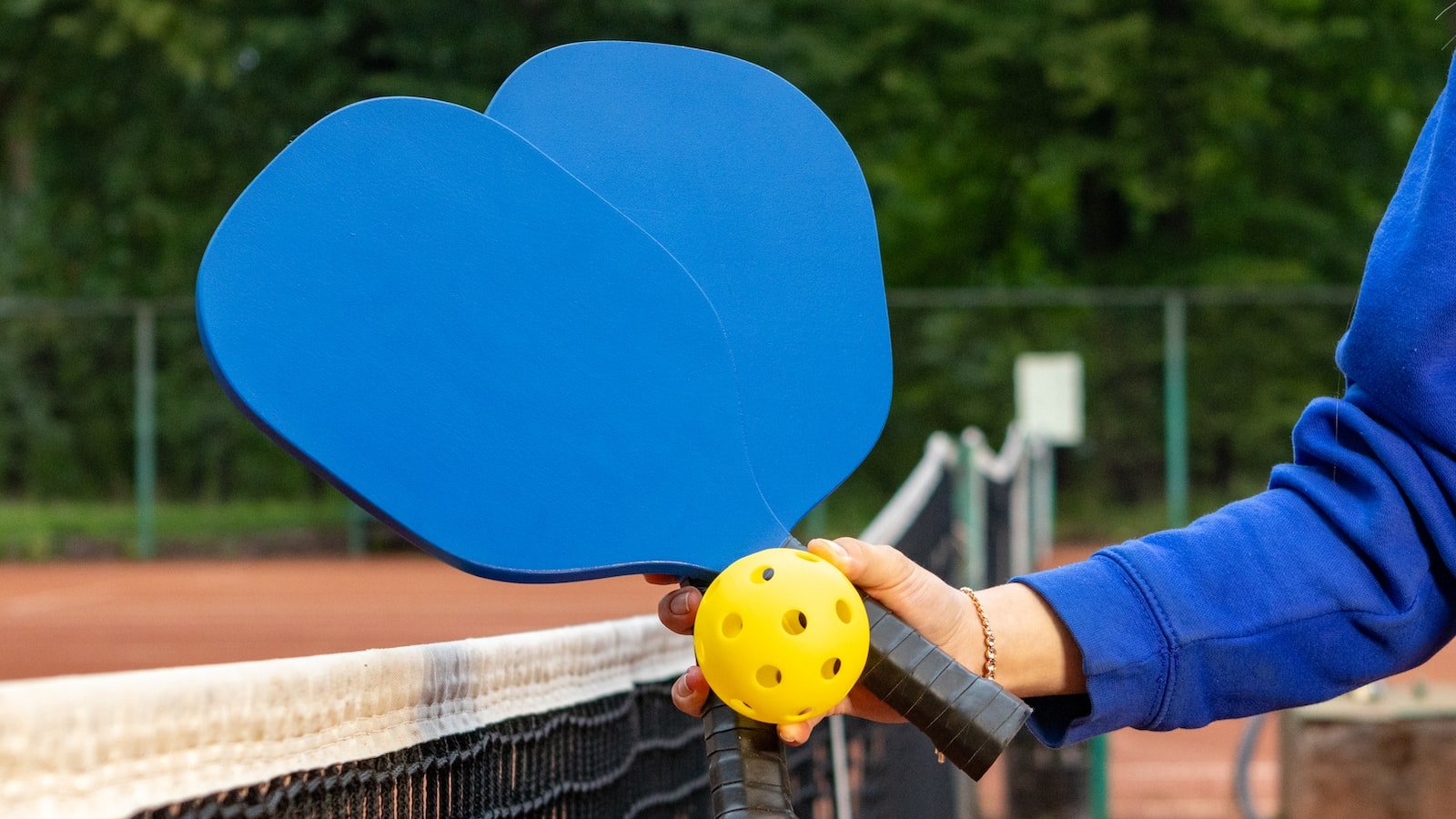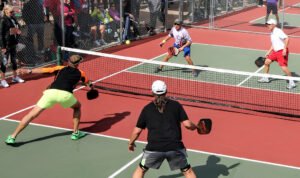Have you ever found yourself wandering onto a pickleball court only to feel completely lost in a sea of foreign phrases like ”dink,” “lob,” and “third shot drop”? Fear not! As the popularity of pickleball continues to rise, so does the need to decode its unique language. Whether you’re a beginner or a seasoned pro, understanding the lingo of this fast-paced sport is crucial to improving your game and connecting with its passionate community. So, grab your paddle, brace yourself for a linguistic adventure, and let’s delve into the fascinating language of pickleball.
Table of Contents
- The Vocabulary of Pickleball: Decoding the Jargon
- Mastering the Slang: Essential Expressions Every Player Should Know
- Unraveling Pickleball’s Lexicon: Must-Know Terms for Beginners
- Navigating the Dialect of Pickleball: Tips for Effective Communication on the Court
- Cracking the Code: Strategies to Learn and Utilize Pickleball Terminology
- Q&A
- Future Outlook

The Vocabulary of Pickleball: Decoding the Jargon
Whether you’re new to pickleball or a seasoned player, understanding the vocabulary of the sport is crucial to navigating the game. Like any other sport, pickleball has its own set of jargon that can seem confusing at first. But fear not! We’re here to help you decode the pickleball lexicon and become a master of the court.
First up, we have the dink. This is a soft shot that is hit just over the net. It requires finesse and precision to execute, as the goal is to place the ball in your opponent’s non-volley zone. Next, we have the third shot drop. As the name suggests, this shot is played as the third shot and is meant to drop the ball near the net, forcing your opponents to hit it back up.
Now let’s talk about stacking. This term refers to the strategy of positioning your team members in a specific order on the court. By stacking, you optimize your shots and cover the court effectively. Another important aspect of pickleball is the kitchen, which is also known as the non-volley zone. This area extends 7 feet from the net and has certain restrictions on when you can step into it to hit the ball.
Finally, let’s touch on the Erne Shot, a daring move where you leap over the kitchen line to hit a volley. This shot is not for the faint of heart, but when executed correctly, it can give you a significant advantage on the court.
These are just a few examples of the vocabulary and jargon in pickleball. As you continue to play, you’ll encounter many more terms and techniques that will enrich your understanding of the game. So dive in, practice, and soon you’ll be speaking the pickleball language fluently!

Mastering the Slang: Essential Expressions Every Player Should Know
When it comes to gaming, mastering the slang is like unlocking a secret language that connects players from all over the world. Whether you’re a newbie or a seasoned player, understanding the essential expressions is crucial to fitting in and communicating effectively. So, grab your virtual notepad and get ready to level up your slang game!
1. GG (Good Game)
Perhaps the most widely used expression, GG signifies sportsmanship and respect towards your opponents. It’s a way of acknowledging a well-played match, win or lose. After an intense round, typing “GG” in the chat is like extending a virtual handshake, showing your appreciation for everyone’s efforts.
2. Noob (Newbie)
In the gaming world, the term “noob” refers to someone who is inexperienced or new to a particular game. Although it can sometimes carry a negative connotation, it’s commonly used among players in a lighthearted manner. So, embrace your noob status with pride, as everyone starts somewhere!
3. AFK (Away From Keyboard)
We all have those moments when real life demands our attention. When you need to step away momentarily, let your fellow players know by using “AFK.” It signals that you’ll be away from the keyboard temporarily and helps avoid any confusion during the game. Just make sure to return before the action ramps up again!
With these essential expressions in your gaming arsenal, you’ll be well on your way to becoming a slang-savvy player. Remember, mastering the slang not only helps you communicate effectively but also fosters a sense of community within the gaming world. So, go ahead and embrace the virtual language of gamers!
Unraveling Pickleball’s Lexicon: Must-Know Terms for Beginners
As a beginner stepping onto the pickleball court, you may find yourself bewildered by the unique jargon that surrounds this exciting sport. Fear not! We’re here to demystify the pickleball lexicon and equip you with must-know terms that will help you navigate the game with confidence.
Whether you’re learning the basics or aiming to become a seasoned player, this insider’s guide to pickleball slang will surely enhance your understanding of the game. So, let’s dive into the lexicon and become fluent in pickleball terminology:
- Dinking: A soft and controlled shot made just over the net, primarily used in the non-volley zone. It’s all about finesse, leaving your opponents scrambling to return the ball.
- Third Shot Drop: A strategic shot played by the serving team during the third shot of the rally. It aims to land softly in the opponent’s non-volley zone, setting up the team to move close to the net.
- Ernie: An audacious move where a player sprints to the side of the court, typically sacrificing their position, to intercept the ball mid-air and hit a powerful winner. It’s a high-risk, high-reward play that can change the dynamics of the game.
- Kitchen: Also known as the non-volley zone, this area is located on both sides of the net and extends seven feet from it. Players are restricted from hitting volleys or smashes while standing within the kitchen, adding an additional layer of strategy to the game.
- Golden Rule: A principle that emphasizes the importance of staying out of the kitchen whenever possible. Adhering to this rule helps players maintain an advantageous position on the court and avoid committing a fault.
By familiarizing yourself with these essential pickleball terms, you’ll be well on your way to becoming a savvy player. So practice your dinks, master your third shot drops, and dare to execute an Ernie when the opportunity arises. Remember to respect the dreaded kitchen and abide by the golden rule for a competitive edge. Now, go forth and conquer the pickleball court with your newfound lexicon knowledge!
Navigating the Dialect of Pickleball: Tips for Effective Communication on the Court
If you’re new to the game of pickleball, you may find yourself lost in a sea of unfamiliar terminologies and slang used by players on the court. Fear not, for navigating the dialect of pickleball can be as rewarding as mastering the game itself. Effective communication is key to any successful team effort, and pickleball is no exception. Whether you’re playing with experienced players or a group of beginners, here are some tips to help you communicate effectively on the court:
- Learn the commonly used terms: Familiarize yourself with common pickleball terminologies such as “dink,” “lob,” “stacking,” and “third shot drop.” By understanding these terms, you’ll be able to understand and respond to your teammates’ instructions and strategies more effectively.
- Use hand signals: Sometimes, words simply aren’t enough to convey your intentions on the pickleball court. Utilize hand signals to communicate with your teammates, especially during fast-paced moments when speaking may be difficult. For example, raising your paddle can signal that you’re ready for a quick exchange or lowering it can indicate that you need them to hold back and slow down the game.
- Listen and observe: Pay attention to your teammates’ body language and vocal cues. This can provide valuable insights into their strategies and allow you to anticipate their moves better. Remember, effective communication is a two-way street, so be sure to actively listen and respond accordingly.
Cracking the Code: Strategies to Learn and Utilize Pickleball Terminology
If you’re new to pickleball or looking to enhance your knowledge of the game, understanding the terminology is essential. By familiarizing yourself with pickleball jargon, you’ll not only improve your communication with fellow players but also gain a deeper understanding of different strategies and techniques. Here are some effective strategies to learn and utilize pickleball terminology:
-
Immerse yourself in the language: Like any new language, the more you expose yourself to pickleball terminology, the quicker you’ll learn it. Watch tutorial videos, read books, join online forums, and engage in in-person training sessions to surround yourself with the language of the game.
- Break it down: Pickleball has specific terms for various shots and game situations. Break down these terms one by one, seeking understanding and practicing each in your games. From “dink” to “loft” to “third-shot drop,” familiarize yourself with the meaning and purpose of each term.
-
Practice with intention: Incorporate proper pickleball terminology into your training sessions. Talk through your shots and strategies using the appropriate terms, reinforcing your understanding while also building confidence in communicating with other players during a match.
Remember, mastering pickleball terminology is not a race but a journey. Take your time, be patient with yourself, and enjoy the process. With these strategies, you’ll soon find yourself confidently cracking the code of pickleball jargon, enhancing your overall gameplay and fostering better communication with your pickleball peers.
Q&A
What is pickleball?
Pickleball is a paddle sport that combines elements of tennis, badminton, and table tennis. It is played with a paddle and a plastic ball on a court that is similar to a badminton court.
What does “dink” mean in the context of pickleball?
In pickleball, a dink refers to a soft shot that is hit just over the net. This shot is usually played when the players are at the non-volley zone or kitchen, aiming to keep the ball low and close to the net, making it difficult for opponents to hit it back.
What is the “third shot drop” in pickleball?
The third shot drop is a strategic shot in pickleball that is used after a serve and return. It is a softly hit shot that is aimed to land in the non-volley zone, forcing the opponents to hit the ball uphill and giving the serving team a chance to move forward and gain control of the net.
What does it mean to “stack” in pickleball doubles?
Stacking is a positioning strategy used in doubles pickleball where the partners on the receiving team take positions on the same side of the court. This is done to create an advantage, allowing one player to have a forehand shot while the other player has a backhand shot.
What is a “drive” shot in pickleball?
In pickleball, a drive refers to a powerful shot that is hit with speed and force, usually aimed to pass opponents. It is a more aggressive shot compared to a dink or a drop shot, and requires good timing and control.
What does “out” mean in pickleball?
In pickleball, “out” refers to a shot or serve that lands outside the boundaries of the court. If a shot is deemed out, it results in a point for the opposing team, and the serve is typically awarded to the other side.
What is the “bounce” rule in pickleball?
The bounce rule in pickleball states that the ball must bounce once on each side of the net before players can start hitting volleys (hitting the ball before it bounces). This rule is applied only during the serve and the return of serve, but after that, players can hit volleys as the game progresses.
What does “side out” mean in pickleball?
In pickleball, “side out” is a term used when the serving team fails to win a point, resulting in the serve being given to the opponents. It generally occurs when a fault or a miss is made during serving, or when the opposing team successfully returns the serve.
What is the “non-volley zone” or kitchen in pickleball?
The non-volley zone, also known as the kitchen, is a 7-foot area on either side of the net in pickleball. Players are not allowed to volley (hit the ball in the air without letting it bounce) any shot while standing inside this zone, except for balls that have bounced inside the zone.
Future Outlook
As the final rally comes to an end, it’s time to bid farewell to the fascinating world of pickleball lingo. We have journeyed together, uncovering the intricacies of this spirited sport, where words and phrases create a unique language all their own. From dinking and stacking to kitchen conflicts and Ernie shots, our exploration has been nothing short of enlightening.
Now equipped with a lexicon of pickleball terms, you are prepared to enter the courts with confidence, armed not only with a paddle but a linguistic prowess that will elevate your game. The conversation on the courts will take on a new dimension as you effortlessly drop words like “third shot drop,” “banger,” and “on the line.” A mere glance or a nod will suffice to communicate with your fellow players, a secret code understood only by those who have delved into the depths of this remarkable sport.
But beyond the jargon lies a deeper understanding of pickleball’s essence. With each term, there is a story waiting to be told, a strategy to be hatched, and a bond to be forged. The language of pickleball not only shapes the way we communicate on the courts but also reflects the camaraderie, resilience, and sheer joy that permeates this vibrant community.
So, as you venture forth into the world of pickleball, remember that the language you speak goes far beyond words. It revolves around shared passion, sportsmanship, and the indomitable spirit that unites players of every level. The lingo may seem intimidating at first, but trust in the process and embrace the uniqueness it brings, for it is through this shared language that friendships are formed, rivalries are kindled, and the beloved game of pickleball continues to thrive.
Whether you find yourself competing in a spirited game or cheering on your favorite players from the sidelines, know that you have gained more than just knowledge of the lexicon. You have joined a community of enthusiasts who live and breathe pickleball, who find solace in the court’s surface, and who understand that the true magic lies not only in the fierce battles but also in the bonds formed within the lines.
So, until our paths cross again, may the language of pickleball resonate within you, guiding your paddle with finesse and your spirit with determination. Embrace the lingo, embrace the game, and let the rhythm of the pickleball court become a part of your very being.
As an affiliate, my content may feature links to products I personally use and recommend. By taking action, like subscribing or making a purchase, you’ll be supporting my work and fueling my taco cravings at the same time. Win-win, right?
Want to read more? Check out our Affiliate Disclosure page.




